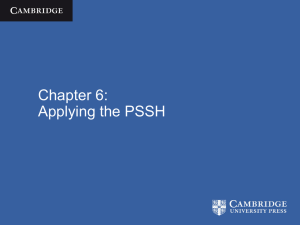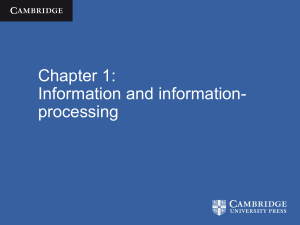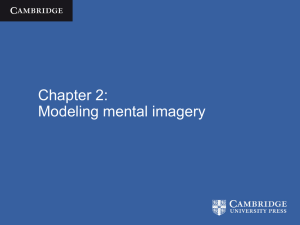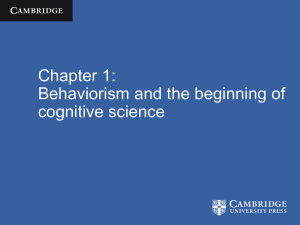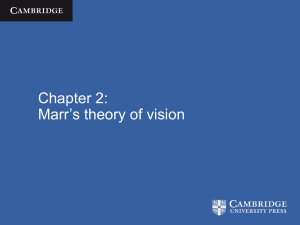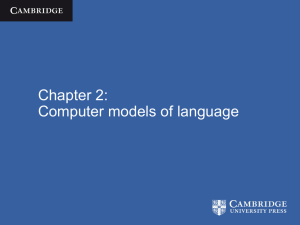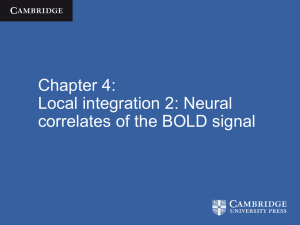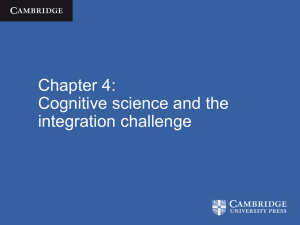Objections to the Physical Symbol System Hypothesis
advertisement
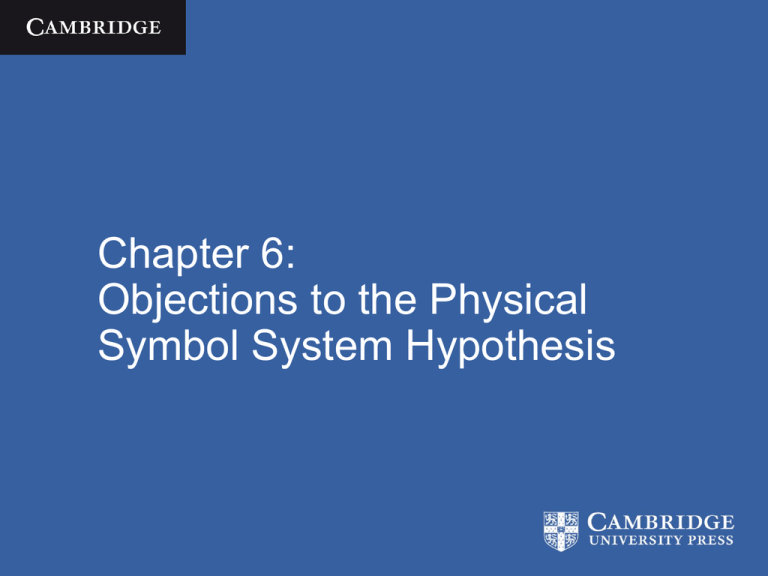
Chapter 6: Objections to the Physical Symbol System Hypothesis Lines of attack • Frame problem • Presents difficulties for the idea of representing knowledge symbolically • Chinese room argument • Challenges the syntactic assumption at the heart of the PSSH Cognitive Science José Luis Bermúdez / Cambridge University Press 2010 Frame problem Original version (McCarthy and Hayes 1969) How can a formal system represent the changes brought about by an action without explicitly representing all the things that the action does not bring about? Cognitive Science José Luis Bermúdez / Cambridge University Press 2010 Frame problem • Originally discussed in context of situation calculus (logic based system of knowledge representation) • Contains axioms about the changes conditional upon certain acts • In order for the system to make deductions it needs to know which states persist – seems to require frame axioms Cognitive Science José Luis Bermúdez / Cambridge University Press 2010 Technical approaches • Default settings: system assumes that nothing changes unless there is an axiom specifying the change • Requires non-monotonic logic (because default assumptions may have to be revised on receipt of new information) Cognitive Science José Luis Bermúdez / Cambridge University Press 2010 Broader versions of frame problem • Some theorists have argued that the frame problem poses an in principle objection to the PSSH • (Alleged) impossibility of formalizing commonsense reasoning • Often accompanied by emphasis on “situatedness” and “embodiment” of real cognitive agents Cognitive Science José Luis Bermúdez / Cambridge University Press 2010 Assessment? • It is hard to know how to assess these arguments without explicit impossibility proofs • The real test comes with the alternative models proposed – Connectionist models of knowledge representation – Embodied/situated AI Cognitive Science José Luis Bermúdez / Cambridge University Press 2010 Syntax •Physical symbol structures are purely syntactic •The symbols do not have any intrinsic meaning •Nor do the expressions built up out of them •The operations on physical symbols are sensitive only to the “shape” of those symbols – Formal rules, like the rules of a logical calculus Cognitive Science José Luis Bermúdez / Cambridge University Press 2010 From syntax to semantics •One can specify a complete machine table for a TM without saying anything about what it is intended to represent (its intended interpretation) •The machine table just specifies what the appropriate transitions are for any possible combination of inputs and states •But if we assign meanings to the symbols then we can interpret the machine as carrying out specific calculations Cognitive Science José Luis Bermúdez / Cambridge University Press 2010 A sample program Q1 0 R Q2 Q1 1 0 Q1 Q2 0 1 Q3 Q2 1 R Q2 • The symbol “R” has a fixed meaning, since it is the instruction to move one square to the right • But “0” and “1” do not mean anything Cognitive Science José Luis Bermúdez / Cambridge University Press 2010 Running the program Q1 0 1 1 0 1 1 0 Q1 Q2 Q2 Q3 0 0 0 0 0 0 0 0 1 1 1 1 0 0 0 1 1 1 1 1 1 1 1 1 0 0 0 0 Cognitive Science José Luis Bermúdez / Cambridge University Press 2010 An interpretation function • An interpretation function gives a semantics • assigns objects to symbols “1” 1 “0” punctuation mark • makes it possible to interpret the TM as computing the function of addition Cognitive Science José Luis Bermúdez / Cambridge University Press 2010 Syntax tracking semantics Syntax: “n” = a string of n “1”s bounded by “0”s “m” = a string of m “1”s bounded by “0”s “n + m” = a string of n + m “1”s bounded by “0”s Semantics: “n” designates n “m” designates m Isomorphism Given inputs “n” and “m” the TM outputs “n +m” “n + m” designates the sum of n + m Cognitive Science José Luis Bermúdez / Cambridge University Press 2010 just when Background to the Chinese room • The Chinese room argument exploits an intuitive contrast between • The way that the outputs of a computer result from operations on strings of symbols (“1”s and “0”s) • The way that human behavior results from rational thought involving propositional attitudes • Searle uses the CRA to argue that this contrast is fatal to the project of strong AI (idea that appropriately programmed computers might be minds) • PSSH is committed to strong AI Cognitive Science José Luis Bermúdez / Cambridge University Press 2010 The Chinese room Cognitive Science José Luis Bermúdez / Cambridge University Press 2010 The main claims • The Chinese Room is input-output identical to a real Chinese speaker • The “internal processing” in the Chinese room is purely syntactic (based on the shapes of the symbols) • The person in the Chinese room has no understanding of Chinese Therefore, what is going on in someone who really does understand Chinese (or anything else) cannot be the sort of processing that takes place in the Chinese room Cognitive Science José Luis Bermúdez / Cambridge University Press 2010 What is genuine understanding? •Clearly cannot be understood in purely behavioral terms •i.e. producing the appropriate outputs for given inputs •The CR passes the Turing Test •Searle: “Understanding a language, or indeed having mental states at all, involves more than just having a bunch of formal symbols. It involves having an interpretation or a meaning attached to those symbols” (In Chalmers, p. 671) Cognitive Science José Luis Bermúdez / Cambridge University Press 2010 Possible responses (1) Reject the intuition that the CR does not understand Chinese (2) Concede that the CR does not genuinely understand Chinese, but find an alternative explanation of the lack of understanding that does not rule out strong AI (3) Concede that the Chinese room does not genuinely understand Chinese, but show how we might build up from the CR to a system that does understand Chinese Cognitive Science José Luis Bermúdez / Cambridge University Press 2010 Strategy 2 • The thought experiment is set up so that the question of whether the CR understands Chinese is equivalent to the question of whether the person in the CR understands Chinese • But our judgment that he does not understand Chinese has nothing to do with syntax vs. semantics • The problem is simply that he has a purely phrase book “command” of Chinese • We standardly distinguish phrase-book understanding from genuine linguistic understanding Cognitive Science José Luis Bermúdez / Cambridge University Press 2010 Strategy 3 • The input-output test is not a good criterion for genuine understanding • It is purely verbal • A much better test of linguistic understanding is whether the CR can interact with the world appropriately • obey instructions and commands • name and describe objects correctly • initiate conversations in a relevant manner Cognitive Science José Luis Bermúdez / Cambridge University Press 2010
